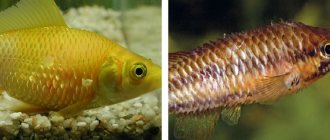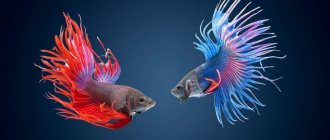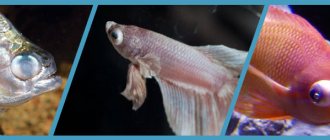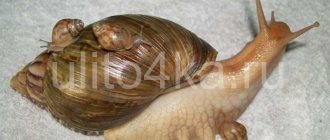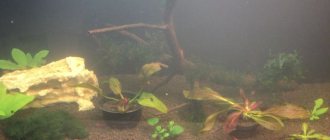Causes
Tetrahymena were first described three hundred years ago. The peculiarity of these ciliates is their ability to quickly reproduce and “kill”.
For some time now they have been common in Russian aquariums and cause a lot of problems even for experienced owners.
Ciliates are capable of parasitizing not only on the host’s body, but also penetrating internal organs, muscle tissue and the brain.
They eat the fry almost entirely. They also parasitize small marine animals and are found in the bodies of dogs and even humans.
And in warm tropical conditions, where aquarium fish are grown for sale, they feel more than comfortable, so the pathogen can be found in every sixth guppies imported from abroad.
Aqualover
English name of the disease: Guppy Disease .
Pathogen: ciliated ciliate corlissi , Tetrahymena pyriformis. This type of ciliate is perhaps the first described single-celled organism; it was described more than three hundred years ago by Anton Levenguk.
Tetrahymena are ciliates widely used in science. In particular, they study the mechanisms of immortality. Tetrahymena have the ability to switch from feeding on bacteria to feeding on the tissues of higher organisms: which leads to the fact that they carry with them concomitant bacterial diseases, as well as great evolutionary and adaptive potential. Ciliates reproduce very quickly.
Today they are found on every sixth imported guppies; they are less common on other fish.
Symptoms: the mucous membrane of fish and fins are affected.
A small pale coating of mucus forms on the body, which then falls off in the form of flakes, the scales become ruffled, not accompanied by dropsy, and at the same time the caudal fin is destroyed (the tail may also begin to shorten), and the gills protrude slightly. The fish greedily swallows air, not reacting to external stimuli, and oscillates in one place. Over time, the ciliates penetrate inside the fish’s body: muscles, abdominal cavity, brain and begin to feed on the fish from the inside. The disease spreads to the internal organs and the fish dies. Tetrahymena can eat the fry almost completely.
Diagnosis: made on the basis of external signs and microscopic examination of smears from areas of the body where signs of the disease are found.
Treatment:
In a general aquarium:
• FMS - 1 ml/100 l., furazolidone 0.5-1 g/100 l, biseptol 480 - 2 tablets/100 l. The course of treatment is at least a week. Furazolidone is able to overcome both tetrahymena from the outside and ciliates that have penetrated into the body of fish. Treatment is carried out in a nursery, since furazolidone strongly suppresses plants. This method also suppresses associated bacterial diseases in fish.
When treating in a septic tank, it is necessary to change up to half of the water daily and add a new portion of the medicine. Healthy fish are given prophylaxis with the addition of these medications to the food (does not harm plants).
Baths (of an auxiliary nature):
• 0.3 g of potassium permanganate per 10 liters of water, no more than 10 minutes;
• 2 ml of 40% formalin per 10 liters of water, 30 minutes.
Additional information: guppies often get sick , but other fish, such as labyrinth fish, may also become the target of tetrahymena attacks.
The disease is often introduced through live food.
In a dirty and “cloudy” aquarium, the disease spreads very quickly.
Treatment
At an early stage, the disease can be defeated if treatment is started immediately.
As part of complex therapy, they resort to the use of FMC or NilpaAquaform; Kostapurot Sera has a similar composition. In addition, NilpaHelamed and NilpaAcriflavine are used and furazolidone is added at the same time. This treatment is indicated for severe lesions.
At the onset of the disease, you can limit yourself to using NilpaAcriflavine and NilpaAkfaform. Biseptol can be used as an antibacterial agent.
It is worth keeping in mind that formalin and furazolidone have a depressing effect on the vegetation living in the aquarium, so if you have plants, you should choose other drugs - JBLPunctol or NilpaProtocid with the addition of delagil or analgin-quinine.
As a preventative measure, it is necessary to place newly purchased fish in a quarantine aquarium.
Tetrahymena symptoms in guppies
Pathogen – Tetrahymena corlissi and Tetrahymena pyriformis
Photo 1
In V. Kovalev’s photo there are two sick males: A – ruffling of scales, B – beginning loss of scales, C – immobilized fin, at the base of which tetrahymenas have settled.
Photo 2 Tetrahymena corlissi
In the old literature you can find treatment methods with malachite green and methylene blue, but, according to reviews of modern aquarists, today treatment with these drugs is not very effective, as is treatment with salt and potassium permanganate.
You will also need an outpatient fish tank. If there is no such thing and there is no opportunity to purchase it, experienced aquarists advise cutting off the top of a 10-liter plastic bottle in which drinking water is sold. For a couple of fish during treatment, such a container will be completely sufficient.
- behavior changes - guppies freeze in one place and begin to make oscillatory movements along the transverse axis of the body;
- guppies begin to try to hide in secluded places or, conversely, after feeding, if the gills are damaged, they begin to choke and rise to the surface;
– ruffling of scales, and unlike dropsy, raising of scales occurs in the absence of general swelling of the body and not throughout the body, but locally; a border can be seen at the edges of the scales under a magnifying glass;
Photo 4 Characteristic ruffling of scales with tetrachymenosis.
- if tetrahymena settle in the gills, the lids begin to protrude and then collapse; the parasites usually first infect one gill, so the fish need to be examined from both sides;
- if the invasion has affected the gills, the guppies begin to choke after feeding;
Photo 6 An atypical case of tetrahymenosis, there is ruffling of scales, penetration of tetrahymena into the body, but the fins have retained their integrity: A - ruffling of scales, B - bloating of the abdomen, into which tetrahymena have penetrated and protruding gills, C - a white stripe of beginning skin exfoliation.
— at the next stage of the disease, the fellings stop responding to external stimuli;
Photo 7 A - a small hole formed in the caudal fin, B - a thin red border on the caudal fin, C - detachment of scales, D - the beginning of protruding gills and a small colony of Tetrahymena corlissi, settled around the eyes.
- a characteristic feature of Tetrahymena in relation to guppies is to form colonies in the peri-ocular areas, so these areas need to be paid attention during daily examination;
- the consequences of the introduction of ciliates into the guppy’s body begin to visually appear - whitish spots visible without a magnifying glass appear, on which a weak matte coating forms from mucus, stripe-like thickenings of the skin develop, and then it begins to peel off in the form of flakes.
Speaking about the symptoms of disease in guppies associated with the destruction of fins, you need to be sure of the normal quality of water in the aquarium, since the fish are quite sensitive to such a parameter as acidity. There is even a disease called alkaline disease. At high pH levels, the fins begin to thin out and seem to “melt” at the edges.
Aquarists have seen good results using combinations of commercial antiparasitic and antibacterial fish medications, such as Sera Costapur and Sera Bactopur.
Treatment with such medications, which can be purchased in an assortment at aquaMegaMall.ru, is carried out strictly in accordance with the manufacturer’s instructions.
If it is impossible to purchase industrially produced medicines, traditional methods are used.
Salt baths - based on (2.5 g/l)
When treating with potassium permanganate, baths are prepared at the rate of 300 mg of the substance per 10 liters of water. The fish is placed in the bath for a maximum of 10 minutes.
When treating with formalin, prepare a solution at the rate of 2 ml. 40% formalin per 10 liters of water and place the fish in the solution for a maximum of half an hour.
When treating a community aquarium with antibiotics, one of the following treatment options is used:
Treatment with FISH PHARMA FMC gives excellent results. It’s easy to make it with your own hands - 3.7 grams of malachite green oxalate and the same amount of methylene blue are dissolved in 1 liter of 37% formaldehyde. You need to purchase substances that are free from zinc (Zn-free), it is better to do this in specialized stores that sell high-quality chemicals. Therapeutic dose is 1.0-1.2 milliliters of solution per 100 liters of water. Every 24 hours, change 50% of the water and add the full dose of medication. To avoid bacterial and parasitic secondary infections in areas affected by tetras, many professional aquarists add one of the following drugs:
- nifurpirinol, if such a medicine is not available in the pharmacy, can be used according to the instructions of sera bakto Tabs, which contains this substance: the medicine is added throughout the treatment;
- metronidazole - the therapeutic dose is 500 milligrams of the active substance per 100 liters of water, the treatment time is from 3 to 5 days;
- oxytetracycline (3 milligrams per 100 liters of water) + neomycin (2 milligrams per 100 liters of water), used for pronounced symptoms of bacterial infections beginning to develop, the duration of use of the drugs is 3 days.
The following method received the most positive feedback from aquarists who decided to treat for tetrachymenosis in the aquarium - add Sera COSTAPUR or JBL Punktol Red Plus to the aquarium water per 100 liters according to the manufacturer's instructions and add 5 tablets of analgin-quinine and 4 tablets of delagil. Every other day, replace ½ of the water and add full dosages of medications again. Duration of treatment - continue for three days after the disappearance of external signs of damage or two weeks.
Instead of Sera COSTAPUR, you can use Sera Pond OMNISAN, which is no less effective - many aquarists choose this medicine because it is cheaper.
Types of aquarium fish most susceptible to hexamitosis
Single-celled flagellates (diplomonas) that populate the intestines of fish come in different types. Depending on which of them provoked the malaise, the following diseases are distinguished:
- Hexamitosis. The pathogens are Hexamita truttae, Hexamita symphysodonis and Hexamita salmonis from the genus Hexamita.
- Octomitosis. The causative agent is Octomitus truttae from the genus Octomitus.
- Spironucleosis. The causative agent is Spironucleus salmonicida and Spironucleus vortens from the genus Spironucleus.
The symptoms of these diseases are largely similar, and in some sources they are collectively called “hexamitosis,” although this is not entirely correct.
The listed pathogens normally live in the intestinal tract of all fish species. However, the pathological process does not always develop. Among decorative aquarium fish, the following are most susceptible to hexamitosis:
- all types of cichlids;
- some labyrinthine (gourami, lalius);
- some characins (affiocharaxes, neons, tetras).
Monitoring of aquarium forums has shown that symptoms of hexamitosis can also be observed in goldfish and some catfish.
Important! Since hexamitosis is one of the invasive infectious diseases, if it is detected in any one individual, it is necessary to treat all the inhabitants of the aquarium.
- Cichlid fish suffer the most from hexamitosis, so owners of cichlids must be able to recognize the onset of the disease in time. Advanced forms, unfortunately, cannot be treated.
Incurable diseases
A diligent fish farmer will read - conditionally incurable or currently incurable. Maybe you will find a way to save your pets from the ailments listed below, then be sure to let us know!
Fish tuberculosis or mycobacteriosis
Symptoms: loss of appetite and rapid weight loss. Intracted belly and hunched back. Dull body color, black eyes and strange behavior - the guppy hides at the bottom, becomes apathetic, lethargic. The luxurious tail hangs, sometimes vertical swimming is observed. All these are symptoms of a terrible disease - mycobacteriosis, or simply fish tuberculosis.
Fish tuberculosis is highly contagious!
This disease cannot be treated. There are either rumors or legends circulating within the aquarium community that someone was lucky enough to defeat fish tuberculosis by mixing antibiotics into the food, but there is no scientific evidence of this. In addition, one of the main signs of tuberculosis is refusal to eat…. Well, decide for yourself how true the rumors are!
However, if such symptoms are detected, it is still necessary to take action, and immediately!
- Place the sick individual in a separate container;
- Disinfect the aquarium, soil, decorations;
- If possible, get rid of plants or thoroughly clean them;
- Carefully observe the rest of the population of the aquarium and, if the slightest suspicion appears, remove a possible patient and repeat steps 1-3.
Plistophorosis
Symptoms: Vertical swimming (the head looks up, the tail is down), when trying to take the natural position of the body, an upward jump occurs, the color turns pale, appetite is lost, up to a complete refusal of food, the stomach becomes sunken.
Causes: plystophorosis in guppies is inherited. This is a very rare disease.
Plystophorosis cannot be treated. All you have to do is destroy the sick guppy and start cleaning the aquarium: rinse it and the decor, boil the soil.
Diseases of one group:
Ichthyophthirvus multifiliis
In sick fish, small white dots first appear on the fins, and later on the entire body. The number of these points can increase rapidly after a few days. Before the dots appear, the fish behave restlessly, rubbing against the ground, plants, etc. When the gills are damaged, severe difficulty breathing occurs. In addition, other symptoms occur: loss of appetite, apathy, often approaching aeration bubbles.
Hexamitosis, or Octomitosis (Hexamita(Octomitus) trutta.)
The fish do not refuse food, but are very exhausted, swim spasmodically, the anus is inflamed, and sometimes the rectum and bladder partially fall out.
Ichthyophthirius, Ick, Ich, white spot
The most common disease. White cysts up to 1 mm in size appear on the fish. Sometimes they form clusters - as if the fish were sprinkled with sugar. Slaves scratch themselves on various objects. A secondary bacterial infection is often present.
Velvet desease (Oodinium)
The body of the fish is covered with yellowish-gray dots. The dots resemble ichthyophthirius, but they are smaller in size and the fish looks as if sprinkled with gold dust. The fish scratches itself on various objects in the aquarium and breathes rapidly through its gills. Sometimes the skin comes off in strips.
Apiosoma (Apiosoma, Glossatella, Heteropolaria colisarum)
In small numbers, Apiosoma parasites are unlikely to cause any external signs, but clusters appear as whitish growths on the skin or fins that can easily be confused with ichthyophthyriasis or lymphocystis. Both diseases are widespread. The diagnosis can be confirmed by microscopic examination, but this is unlikely to be necessary. Ichthyophthyriasis can be distinguished by the rapid spread of infection. It quickly spreads throughout the fish’s body and spreads to other fish. Lymphocystosis causes the appearance of spherical neoplasms that form clusters like a bunch of grapes or cauliflower. Fluffy plaque or growths on places where the mucous membrane is damaged, which is difficult to confuse with a fungus, since the fungus has much longer threads.

